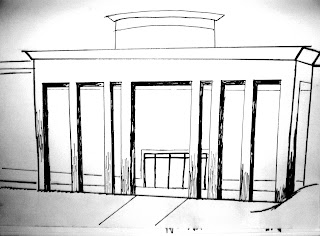In architecture, one always starts at the beginning, where most things should. An archetype is the beginning steps of a process, it is a general example of something. A prototype is then derived from the original archetype. It branches out from the original and begins to form the final product. To emphasize one point of something we create hierarchy and order. Order allows us to make sense of something. Hierarchy draws your eye to specific point with an entourage that surrounds and enhances it. Finally, with help from other sources, one creates the hybrid, a mix of everything. All these parts work to finalize a whole, without one piece we loose everything.

Archetype/ Prototype/ Hybrid. An
archetype is a very broad general example of something. I has no specifics and is usually just a basic object. In Roman Architecture, a basic Doric Column would be an
archetype. A
prototype, "is a model on which something is based or formed" (
dictionary.com). An example of a
prototype would be the Tuscan Column. It branches out from the original Doric column, but begins to lead to the newest model. A
hybrid is formed or composed from two, or more, different objects. The Composite column would be an example of a hybrid. "The composite order is a mixed order, combining the volutes of the Ionic order with the acanthus leaves of the Corinthian order" (
wikipedia.com). Above are a few sketches of the mentioned columns.


Source. A
source is where you derive ideas from. It is something that guides you along the way and is, "any thing or place from which something comes, arises, or is obtained; origin" (
dictionary.com). A
source can also provide information about things that you may of may not know. Above is a picture of an athenian coin with the owl of wisdom pressed into it, the drawing next to it is my class notes for the day. I used the picture of the owl as a source to help me draw and remember the coins significance.

Entourage. An entourage is the surroundings of an object. Every object or thing has some sort of entourage. An object may stand alone, but it still has it's surroundings, the room its in, the shelf its on, the case it's displayed it. An entourage is anything around a particular thing. Above is a series of vignettes that I completed for Suzanne's class. The focus can be placed on one picture and everything else surrounding it is an entourage.

Hierarchy. "A
hierarchy is an arrangement of items, objects, names, values, categories, etc." (wikipedia.com) One example of hierarchy is found in the greek and roman columns. "The Greek orders consisted of Doric, Ionic, and Corinthian. To these the Romans added the Composite (a combination of the Ionic and Corinthian) and the simpler and heavier Tuscan Doric" (Roth 31). Hierarchy is also found in line and line weights. The darker the line the important it is, the bigger a letter the more import as well. It has a great deal to do with visual aesthetics. Above is an example of line weight.

Order.
Order also has a lot to do with visual aesthetics. It is "the disposition of things following one after another, as in space or time; succession or sequence" (
dictionary.com).
Order is greatly related to the Greek and Roman columns. They are set in a sequential
order: Doric, Ionic, Corinthian, Tuscan Doric, and Composite (Roth 31, Image 2.9).
Order is a way of making sense out of things. Above is a series of thumbnails I completed for my studio class, they are all of the same object and placed (or
ordered) into a specific pattern.





 Moment. Moments are created everywhere you go. With every drawing you sketch, every picture you take, every painting you brush, a moment is formed. When i think of the word moment, I think of capturing a scene forever, grasping onto a picture and holding it through time, taking hold of something that will never change. "You must live in the present, launch yourself on every wave, find your eternity in each moment" (Henry David Thoreau). Above is a moment that I captured and drew of a girl studying in the book store in the EUC.
Moment. Moments are created everywhere you go. With every drawing you sketch, every picture you take, every painting you brush, a moment is formed. When i think of the word moment, I think of capturing a scene forever, grasping onto a picture and holding it through time, taking hold of something that will never change. "You must live in the present, launch yourself on every wave, find your eternity in each moment" (Henry David Thoreau). Above is a moment that I captured and drew of a girl studying in the book store in the EUC.
































